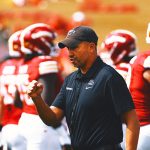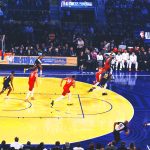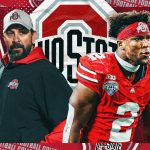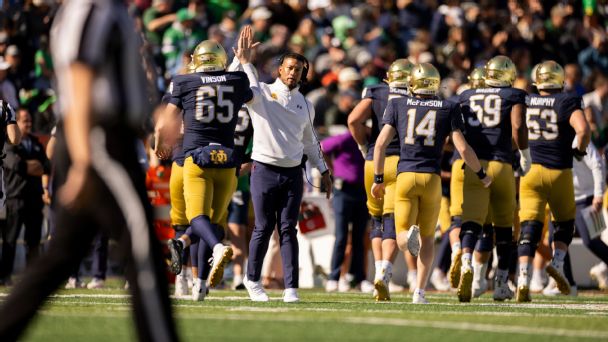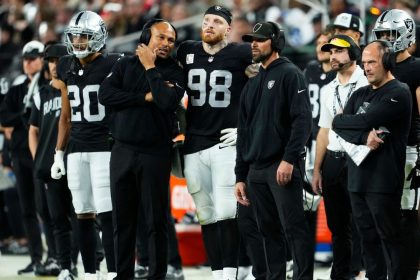
The independent ranks have swung and swayed in recent years. As recently as 2022, we had seven of them, but BYU joined the Big 12, and Liberty and New Mexico State gratefully joined Conference USA. With Army joining AAC in football this year, and UMass re-joining the MAC in 2025, we could soon be down to only two: forever-independent Notre Dame and UConn.
For now, however, we sort of have five: three indies and a Pac-2. As you probably remember, the Pac-12 was torn apart last year, with four schools departing for the Big Ten (Oregon, UCLA, USC, Washington), four more leaving for the Big 12 (Arizona, Arizona State, Colorado and Utah) and, out of sheer desperation, two fleeing for the ACC (Cal, Stanford). Despite recent on-field success, Oregon State and Washington State were evidently too geographically remote to draw the Big 12’s attention. It’s unclear what they intend to do for a future conference home, but in 2024 they’re independents. They have scheduling arrangements with the Mountain West for football and the West Coast Conference for other sports, and their games will air on Fox and The CW this fall.
So we’ve got five independent or indie-like teams, all in either the Northwest, Northeast or Northern Indiana. Let’s preview them!
Every week through the summer, Bill Connelly will preview another FBS conference exclusively for ESPN+, ultimately including all 134 FBS teams. The previews will include 2023 breakdowns, 2024 previews and team-by-team capsules. Here are the MAC, Conference USA, AAC, MWC and Sun Belt previews.
Jump to a section:
https://www.espn.com/college-football/insider/story/_/id/40444584/independents-2024-preview-notre-dame-oregon-state-washington-state#games”>Best games
https://www.espn.com/college-football/insider/story/_/id/40444584/independents-2024-preview-notre-dame-oregon-state-washington-state#good”>Who might be good
2023 recap
Notre Dame and its temporary new indie mates Oregon State and Wazzu had almost directly opposite seasons. The Beavers and Cougars defiantly charged out of the gates after the terrible realignment developments — OSU rose as high as 15th in SP+ during a 6-1 start (in which the only loss was to Wazzu), while Wazzu rose to 20th during a 4-0 run that featured wins over OSU and Wisconsin. But the Cougs lost seven of their final eight, a run that featured four one-score defeats and no bowl bid. OSU, meanwhile, held on a bit longer, reaching 8-2 before a narrow loss to Washington. But the Beavers finished the year losing by a combined 71-15 to Oregon and Notre Dame. Then, to add insult to injury, OSU head coach Jonathan Smith left for Michigan State.
The Irish, meanwhile, were up and down, jumping to fourth in SP+ after a 4-0 start then losing to Ohio State and playing poorly in a loss to Louisville. But they won five of their final six games, losing only at Clemson and overachieving against SP+ projections by an average of 15.8 points per game. They finished eighth in SP+, and were on the rise when the season ended.
2024 projections
Wazzu got hit by transfers, and Oregon State got wrecked by them. Nine Beavers starters entered the portal, in addition to those who had already run out of eligibility. As you’ll see below, they are in the nation’s bottom three in returning production and are projected to fall out of the top 50. Wazzu is projected to stay approximately the same, and so is Notre Dame. UConn and UMass, meanwhile, remain hard jobs for their respective veteran coaches, both of whom did intriguing work in the transfer portal.
With a nearly 50-50 chance to reach 11 or more wins, Notre Dame is well-positioned to make a run to the freshly expanded College Football Playoff. I’m curious where they fall if they go 10-2, though. The Irish’s schedule is an odd mix of big-time matchups — at Texas A&M in Week 1, Louisville in Week 5, Florida State in Week 10, at USC in Week 13 — and an otherwise soft slate. All four opponents I just listed are projected in the SP+ top 30, but the next-best opponent on the schedule is Miami (Ohio), projected 62nd.
Regardless, Marcus Freeman’s third Irish team has an immense ceiling and a chance to do some big things. We’ll see about the other indies.
Best games of 2024
Here are the best games involving independents that feature both (a) the highest combined SP+ ratings for both teams and (b) a projected scoring margin under 10 points.
Notre Dame at Texas A&M (Aug. 31). Indeed, Notre Dame’s schedule features lots of likely wins — nine games with a projected advantage of 15 or more points — but the year starts with a tossup. Win this battle of former Fighting Irish defensive coordinators (Marcus Freeman vs. new A&M head coach Mike Elko), and Notre Dame’s probably spending the first two months of the season high in the polls.
Washington State at Boise State (Sept. 28). Wazzu plays three teams projected 42nd or better in SP+, and they all show up on the September portion of the schedule. This one’s the third of the three and will set the stakes for the rest of the Cougars’ season.
Florida State at Notre Dame (Nov. 9). The biggest game of Notre Dame’s season. Among all games outside of the Big Ten and SEC, this one has the highest combined SP+ rating among the teams. Huge.
Notre Dame at USC (Nov. 30). We don’t quite know what to expect from USC this year, but this one might be a “win, and you’re in” sort of game for Notre Dame. You’d very much prefer to be playing those games at home.
Oregon State at Boise State (Nov. 30). This matchup is always going to feel right — bright orange versus bright blue — though Oregon State playing Oregon in September and BSU in late-November is incredibly disorienting.
I haven’t mentioned UConn and UMass much in this piece yet. By the definitions above, here are the “best” games of the Huskies’ and Minutemen’s seasons, too.
Eastern Michigan at UMass (Aug. 31). There aren’t all that many paths to bowl eligibility for the Minutemen, but I’m guessing most of them involve winning the home opener.
Rice at UConn (Oct. 26). SP+ doesn’t love the Huskies, but I will say that the home schedule features a number of potential wins — Merrimack, Buffalo, Temple and Georgia State are all projected 107th or worse, and Rice is only 89th — if they’re just a little bit better than projected.
CFP contenders
![]()
Head coach: Marcus Freeman (third year, 19-8 overall)
2024 projection: 10th in SP+, 10.3 average wins
In the last 27 seasons, Notre Dame has finished in the 93rd percentile of the SP+ ratings — something approximate to about a top-7 to top-10 level — five times. The Fighting Irish are almost always good, but in those years they have been elite or very close to it. The five seasons:
-
2012, when they started 12-0 and reached the BCS Championship against Alabama (we won’t talk about what happened in that game).
-
2017, when they ripped off maybe the most dominant run of the Brian Kelly era — a six-game stretch (including wins over ranked USC and NC State teams) with an average score of 43-16 — before stumbling down the stretch.
-
2019, when they lost only at Georgia and Michigan and won 11 games by an average of 25.6 points. (They actually made the CFP in 2018, but with a less dominant team.)
-
2020, when they began the abbreviated season 10-0 and reached the CFP but got manhandled by Clemson (in the ACC title game) and Alabama to end the year.
-
2023, when they lost three games by an average of eight points and won 10 by an average of 33.
The main point of laying all that out is to reinforce one simple idea: Notre Dame’s upside was high last year. The midseason road losses to Louisville and Clemson lowered the stakes for the rest of the year and produced a mere Sun Bowl bid at the end, but the Irish beat three different top-40 teams by at least 21 points each. They were excellent.
To assume that the Irish will build on last season’s success, we have to assume that Freeman’s recent roster-building, both in terms of transfer moves and high school recruiting, is ready to bear fruit. Notre Dame ranks 97th in returning production, and probably about six or seven of last year’s top 10 players are gone.
It’s not hard to feel pretty optimistic, though. Duke senior Riley Leonard will replace last year’s QB rental, Sam Hartman, and if fully healthy — a solid “if” considering he’s had two ankle surgeries this offseason, and mobility is a big part of his game — his upside is probably even higher than Hartman’s. Sophomore running backs Jeremiyah Love and Jadarian Price are each major breakout candidates. Love is a former top-100 recruit, and Price was one of the best kick return men in the country as a freshman. Mitchell Evans is one of the country’s best tight ends, and Freeman added three explosive receivers via the portal, including the battle-tested Beaux Collins (Clemson) and one of the best receivers in the Group of 5 last year, Kris Mitchell (Florida International).
Defensive tackles Howard Cross III and Rylie Mills (combined: 17 TFLs, 24 run stops, 4.5 sacks last year) form one of the country’s more proven duos up front, and in the back, the Irish have both an elite corner (Benjamin Morrison) and elite safety (Xavier Watts).
There are serious question marks: How effective can the offense be if Leonard’s ankle isn’t ever 100%? Is one of the other QB options (sophomore bowl hero Steve Angeli, redshirt freshman Kenny Minchey, freshman CJ Carr, Notre Dame-turned-Alabama-turned-Notre Dame transfer Tyler Buchner) ready to shine? How much will losing three awesome starters hurt a usually awesome offensive line? Is cornerback depth as big a problem as it looks on my Notre Dame spreadsheet? But the questions feel more answerable when you start with that many known entities.
My favorite player: CB Benjamin Morrison. He was a solid recruit — low four stars — if not a five-star sure thing, but from the moment Morrison first donned the Irish uniform, he’s been one of the best corners in college football. Over two years, he has allowed a 33% completion rate, four touchdowns to nine interceptions and a QBR of 18.6.
Here’s his coverage map from last year.
He allowed a handful of catches near the line of scrimmage (on the left, at least). But if he’s near your intended receiver downfield, just look for someone else to throw to.
A good season wouldn’t be a surprise
![]()
Head coach: Trent Bray (first year)
2024 projection: 55th in SP+, 7.5 average wins
When four Southwest Conference programs (Houston, Rice, SMU and TCU) got left behind by the Big 12’s formation in the mid-1990s, it stunk. The realignment machine revved up and turned four power-conference programs into mid-majors of sorts. But they could at least take consolation from the fact that they mostly already stunk. In the four years before the SWC’s collapse, they had combined for four winning seasons (all 6-5 or 7-5) and an overall record of 55-116-6.
Oregon State, on the other hand, is coming off of three straight winning seasons. The Beavers enjoyed their highest poll finish in 22 years in 2022, then spent a chunk of last year in the top 10. After a slow rebuild for Smith, this program was in increasingly strong shape, and it was left behind by the realignment machine while quite a few schools that have been far worse than OSU salvaged at least a Big 12 or ACC bid.
It just stinks, is what I’m saying. The only comparable move I can think of is Cincinnati’s demotion from a BCS conference (Big East) to non-BCS (AAC) just three years after the Bearcats nearly reached the BCS Championship.
The calendar changes regardless, though, and no matter who isn’t still in Corvallis — Jonathan Smith, quarterback DJ Uiagalelei and plenty of others — the Beavers will still field a team. And demoted schedule or not, SP+ projects them as favorites in nine of 12 games. There’s no telling what the college football landscape will look like in a few more years or decades, but as Cincinnati recently found out, no matter how unfair your circumstances, being good at football still makes it more likely that you’ll like your future situation.
There will be plenty of individually interesting players wearing an OSU jersey this fall. Whether rookie head coach Trent Bray can craft something cohesive out of them remains to be seen. Between junior Ben Gulbranson, Idaho transfer Gevani McCoy and Missouri redshirt freshman Gabarri Johnson, a solid QB could emerge. Gulbranson threw for 1,455 yards as a part-timer in 2022, and McCoy was a Big Sky delight last year, throwing for 2,910 yards and becoming a Walter Payton Award finalist. The skill corps has been completely overhauled, but well-traveled Ole Miss transfer Jam Griffin might have something to offer, and players like running back Jake Reichle and receivers Jimmy Valsin III and Jeremiah Noga were small-sample all-stars, at least. On defense, well, the secondary could be solid, especially corners Jaden Robinson and Liberty transfer Kobe Singleton. But nine players logged at least 200 snaps in the front six, and they’re all gone. Bray will have to hope that six transfers, including tackle Tygee Hill (LSU) and FCS star defensive ends Nick Norris (seven TFLs at Northern Colorado) and Josh Griffis (8.5 TFLs at Tarleton State), could help to form something decent.
My favorite player: CB Jaden Robinson. Throwing deep on Robinson works out about as well as throwing deep on Benjamin Morrison. Quarterbacks threw at least 20 yards downfield on Robinson 11 times last year, and he allowed just two completions with three breakups. For that matter, he allowed only a 40% completion rate and 39.6 QBR on any pass. Newcomer Kobe Singleton had four interceptions with 10 breakups at Liberty last year, too. That’s an awfully impressive duo there.
![]()
Head coach: Jake Dickert (fourth year, 15-16 overall)
2024 projection: 59th in SP+, 7.6 average wins
At least Oregon State had the decency to stink until just a few years ago. Over the last nine seasons, Washington State produced a 0.589 overall win percentage, the fifth-best in the Pac-12, ahead of one Big Ten-bound team (UCLA), two new ACC teams and four new Big 12 teams. Granted, that time period includes five Mike Leach bowl teams, and things have slipped a bit in the years that followed. This has been an above-average program for a while.
The one good thing about the current situation is, if Wazzu maintains its recent level of play, the Cougars will win plenty of games. And if they do eventually land in the Mountain West, or a new version of the Pac-12 that looks an awful lot like the MWC, then they’ll be among the better programs in the Group of 5, with the hope of a CFP bid that comes with that.
Dickert has quite a bit of work to do to maintain that level of play, however. The Cougs return only five starters on offense (four on the line, one elsewhere) and about four on defense. Dickert did nice work bringing in four players who started for FBS teams last year (including Oregon slot man Kris Hutson), plus a number of FCS stars like Bryant quarterback Zevi Eckhaus (2,907 passing yards, 353 rushing yards, 33 total TDs), Austin Peay receiver Tre Shackelford (15.4 yards per catch, 6 TDs), Utah Tech defensive end Syrus Webster (12.5 TFLs) and Portland State linebacker Parker McKenna (75 tackles, 9 TFLs). The O-line, linebacking corps and secondary should be strong, and between Eckhaus and 2023 backup John Mateer, odds are solid that a promising QB emerges. Coordinator Ben Arbuckle’s prolific and QB-friendly attack will help.
The biggest concerns are the skill corps and the defensive edge. Five players saw more than 80 intended touches (carries plus pass targets) last year, and four are gone. Hutson, Shackelford and Louisiana Tech transfer Kyle Maxwell could combine with senior Kyle Williams and sophomore Carlos Hernandez to form a rock solid receiving corps, and young running backs Djouvensky Schlenbaker and Dylan Paine might have potential, but there’s a lot of new-ness there for a new QB. And while Webster’s exciting at defensive end, Brennan Jackson and Ron Stone Jr. are gone after combining for 28 TFLs, 20 run stops and 13.5 sacks. The bar is high.
My favorite player: WR Kyle Williams. He was only the No. 3 target last season, but he was a talisman of sorts. He averaged at least 2.0 yards per route run while the game was within one score six times, and in those games Wazzu averaged 37.7 points per game. When he didn’t, Wazzu averaged 25.7 points per game. Get Williams rolling, and the rest of the offense will likely follow suit.
Just looking for a path to 6-6
![]()
Head coach: Jim Mora (third year, 9-16 overall)
2024 projection: 126th in SP+, 4.2 average wins
The last two years of UConn football have given SP+ plenty of “Well, actually…” fodder.
In 2022, Jim Mora’s first year in charge, the Huskies were one of many delightful turnaround stories, charging from 1-11 to 6-7 and bowling for the first time in seven years. But well, actually, two of the wins came against teams ranked 130th and 131st in SP+, another came against a poor FCS team, they enjoyed some turnovers luck, and they got lucky breaks in a couple of upset wins. SP+ saw no reason to think the Huskies had genuinely improved all that much (a little on defense, none on offense) and ranked them 129th accordingly.
Last season, the Huskies tumbled to 3-9, forfeiting any sense of progress. But well, actually, their 1-4 record in one-score games and negative turnovers luck suggested they were unlucky, and their performances in losses to NC State (24-21), USF (24-21) and Boston College (21-14) hinted at minor improvement. Their offense improved a little, their defense a little more, and they improved nine spots in SP+ despite the record.
For everything but the win column, the story of Mora’s tenure has been slow progress. The Huskies are still waiting on some semblance of continuity at QB — they are sure to have a new leading passer for the seventh consecutive season — and the fact that Mora is welcoming more than 20 transfers to town in year three shows that the roster is in no way close to where he wants it to be. But he did some pretty impressive work in the transfer portal, too, and UConn should have a more talented roster because of it.
Oklahoma/Wisconsin transfer Nick Evers will compete with senior Joe Fagnano, last year’s backup, to start at QB, and the skill corps features both solid mainstays — running backs Cam Edwards and Victor Rosa, receiver Brett Buckman — and former high-three or four-star recruits like running back Durell Robinson (Charlotte) and receivers Skyler Bell (Wisconsin), TJ Sheffield (Purdue), Shamar Porter (Kentucky) and Ezeriah Anderson (Campbell). I’m not sure the line has what it needs, but if nothing else it has length at tackle with Chase Lundt (6-8) and Valentin Senn (6-7).
We’ll see if the offense can finally take a real step forward, but it’s easy to see potential for another year of defensive improvement. Of the 14 players who saw 300-plus snaps, eight return, including stars in end Pryce Yates and tackle Dal’mont Gourdine. But Mora was still aggressive, bringing in four transfer linemen, three linebackers — including excellent disruptors in Troy’s Jayden McDonald and Tulsa’s Julien Simon — and four DBs.
My favorite player: DE Pryce Yates. The raw stats tell the story well enough: Yates had 12 tackles for loss, 4.5 sacks, 9 run stops, 2 pass breakups, and a forced and recovered fumble. All good things. But the junior from San Antonio is a serious difference-maker. Over the last two seasons, when Yates made at least two havoc plays (TFLs, passes defended, forced fumbles) in a game, UConn went 5-3 and allowed just 19.0 points per game. When he made fewer than two, UConn went 4-13 and allowed 32.2 PPG.
![]()
Head coach: Don Brown (eighth year, 47-39 overall, 4-20 in second stint)
2024 projection: 128th in SP+, 4.0 average wins
There are plenty of frustrating aspects about this current era of football. I’ve listed a few of them in this piece already, but the elimination of transfer restrictions has done at least one pretty cool thing: It’s allowed water to find its level. The portal hasn’t offered schools shortcuts for matching the death-star talent levels of the Georgias or Alabamas or Ohio States of the world, but talent has been redistributed in a cool way. Case in point: UMass.
Don Brown’s Minutemen program has certainly been hit by some of the down sides of portal life — namely, that eight starters (including at least a couple of last year’s best players) have left — but by my count, Brown has put together a roster that includes both 10 former blue-chippers and a number of smaller-school playmakers. I like that a lot. Granted, it might not help UMass to rise all that far in the FBS universe because other schools have also amassed fun levels of talent, but Brown’s doing interesting things. We’ll see if they pay off.
Despite Brown’s track record as a successful defensive coordinator, the offense took the first step forward in the second year of his second UMass tenure. Quarterback Taisun Phommachanh (one of the aforementioned former blue-chippers) returns, as does senior slot man Anthony Simpson, but further improvement will require breakthroughs from transfers like running back Brandon Campbell (Houston), receivers Frank Ladson Jr. (Miami) and Keshawn Brown (Duquesne), or any of the seven offensive linemen moving to Amherst. It feels like the talent level has indeed improved on offense, but veteran offensive coordinator Shane Montgomery has to make something cohesive out of it.
Don Brown defenses want to be as aggressive as possible, and UMass both blitzed a ton (43% of opponent dropbacks, sixth-most in FBS) and forced a lot of incompletions (57% completion rate, 15th). But opponents ran the ball at will on the Minutemen, and if they completed a pass, it was going a long way. The secondary returns a solid cornerback in Isaiah Rutherford and welcomes six smaller-school transfers to town, including Lake Ellis (11 passes defended at FCS’ Bryant) and Brennen Bailey (12 passes defended as a freshman at D2’s West Liberty). Brown tried to add solid beef in the form of tackles Tim Grant-Randall (Eastern Michigan) and Etinosa Reuben (Georgia Tech), but there’s still a defined lack of 300-pounders up front.
My favorite player: WR Anthony Simpson. Simpson basically served as both the No. 1 receiver and, with a load of short, safe and relatively efficient targets, the No. 2 running back.
On passes thrown five or fewer yards downfield, Simpson averaged 5.1 yards per target (a decent rushing average!), and while he only caught nine of 21 passes thrown more than 15 yards downfield, he averaged 41 yards per catch on those. Safe possession man? Check. Serious deep threat? Check.

